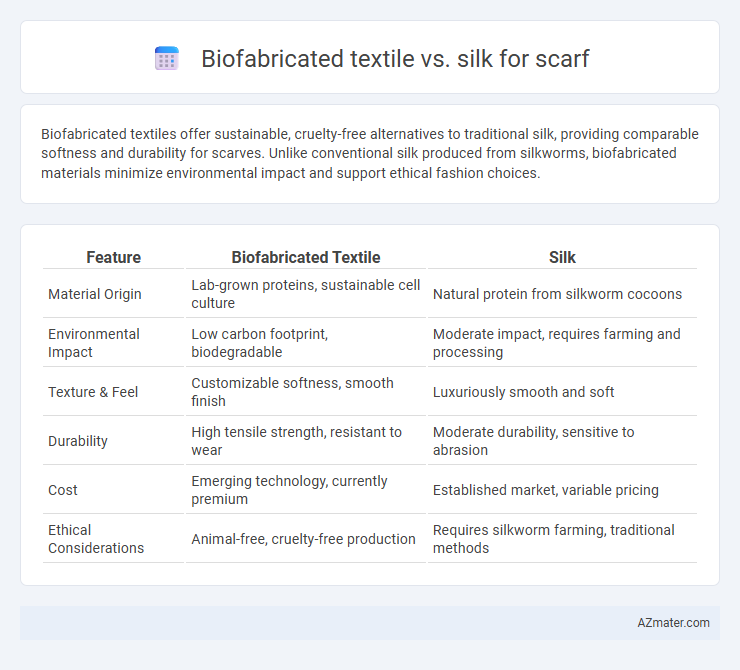Biofabricated textiles offer sustainable, cruelty-free alternatives to traditional silk, providing comparable softness and durability for scarves. Unlike conventional silk produced from silkworms, biofabricated materials minimize environmental impact and support ethical fashion choices.
Table of Comparison
| Feature | Biofabricated Textile | Silk |
|---|---|---|
| Material Origin | Lab-grown proteins, sustainable cell culture | Natural protein from silkworm cocoons |
| Environmental Impact | Low carbon footprint, biodegradable | Moderate impact, requires farming and processing |
| Texture & Feel | Customizable softness, smooth finish | Luxuriously smooth and soft |
| Durability | High tensile strength, resistant to wear | Moderate durability, sensitive to abrasion |
| Cost | Emerging technology, currently premium | Established market, variable pricing |
| Ethical Considerations | Animal-free, cruelty-free production | Requires silkworm farming, traditional methods |
Introduction: Biofabricated Textiles and Silk Scarves
Biofabricated textiles are engineered from cultured cells, offering sustainable alternatives to traditional materials like silk, which is produced from silkworm cocoons. Silk scarves, prized for their natural luster, smooth texture, and breathability, have been a luxury textile choice for centuries. Advances in biofabrication technology enable the creation of eco-friendly scarves with comparable softness and durability, reducing reliance on animal-based silk production.
Defining Biofabricated Textiles
Biofabricated textiles are engineered materials grown from biological cells through sustainable and innovative biotechnological processes, offering eco-friendly alternatives to traditional fabrics. Unlike silk, which is harvested from silkworms and involves extensive farming and processing, biofabricated textiles reduce environmental impact by eliminating animal exploitation and minimizing resource consumption. These textiles exhibit customizable properties, such as enhanced durability, breathability, and biodegradability, making them ideal for luxury accessories like scarves that combine sustainability with high performance.
The Legacy and Appeal of Silk
Silk, with its centuries-old legacy rooted in ancient China, remains a timeless symbol of luxury and elegance, prized for its natural sheen, softness, and durability. Biofabricated textiles, emerging from cutting-edge biotechnology, offer sustainable alternatives by replicating silk's unique properties without the environmental impact of traditional sericulture. While silk's appeal is deeply connected to cultural heritage and artisanal craftsmanship, biofabricated fabrics represent innovation-driven luxury focused on ethical production and resource efficiency.
Production Process: Biofabricated Textiles vs Silk
Biofabricated textiles are produced through microbial fermentation or cell culture, enabling sustainable and scalable fabric creation without traditional animal farming. In contrast, silk production involves sericulture, where silkworms spin cocoons that require careful harvesting and processing, often raising ethical and environmental concerns. The biofabrication process reduces resource use and waste, offering an eco-friendly alternative to conventional silk harvesting.
Sustainability Comparison: Eco-impact of Each Material
Biofabricated textiles offer a significantly lower environmental footprint compared to traditional silk, relying on lab-grown proteins that reduce water usage by up to 90% and eliminate the need for mulberry cultivation or silkworm farming. Silk production typically involves high water consumption, pesticide use, and greenhouse gas emissions from agriculture and processing stages, contributing to greater ecological strain. Choosing biofabricated textiles for scarves supports resource conservation, minimizes chemical pollution, and promotes biodegradable, cruelty-free fashion alternatives.
Texture, Comfort, and Wearability
Biofabricated textiles offer a smooth, consistent texture that rivals the natural softness of silk, enhancing comfort for sensitive skin. These innovative materials provide improved breathability and moisture-wicking properties, making them ideal for all-day wear. Compared to silk, biofabricated scarves demonstrate higher durability and easier maintenance, increasing their practicality without compromising luxury.
Design Versatility and Color Options
Biofabricated textiles offer unparalleled design versatility and a broader spectrum of color options compared to traditional silk, enabling intricate patterns and vibrant hues through advanced manufacturing technologies. Unlike silk, which relies on natural dyeing methods limiting colorfastness and variety, biofabricated materials can integrate custom pigments and textures at the molecular level for consistent and innovative designs. This adaptability makes biofabricated scarves ideal for fashion-forward consumers seeking unique aesthetics without compromising sustainability.
Durability and Care Requirements
Biofabricated textiles demonstrate superior durability compared to traditional silk scarves, resisting wear, tear, and environmental damage more effectively due to their engineered fibers. Care requirements for biofabricated scarves are more convenient, often allowing for machine washing and reduced sensitivity to detergents, unlike silk which demands delicate hand washing and stringent handling to maintain its quality. This enhanced durability and simplified maintenance make biofabricated textiles a sustainable and practical alternative to silk in scarf production.
Price and Market Availability
Biofabricated textiles for scarves generally come at a higher price point than traditional silk due to advanced production technologies and limited large-scale manufacturing. Silk remains widely available in global markets with competitive pricing driven by established supply chains and mass production. Consumer preference is gradually shifting toward biofabricated options as innovation improves scalability and reduces costs, though silk dominates current market accessibility.
Future Trends: Biofabricated Textiles vs Traditional Silk
Biofabricated textiles, engineered through sustainable biotechnological processes, are poised to revolutionize scarf production by offering customizable textures and enhanced durability compared to traditional silk. Emerging innovations in biofabrication enable precise control over fiber properties, reducing environmental impact and addressing the ethical concerns tied to silk harvesting. Future trends suggest a growing market shift toward biofabricated scarves that combine luxury aesthetics with eco-friendly credentials, challenging silk's long-standing dominance in high-end fashion accessories.

Infographic: Biofabricated textile vs Silk for Scarf
 azmater.com
azmater.com